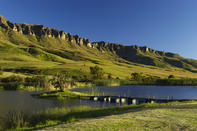Good site selection is very important for successful freshwater aquaculture (fish farming). New aquaculture farmers often start with a piece of land and then look for funding. Others may have funding for aquaculture available and then need to look for suitable land.

Whichever way it starts, new aquaculture farmers need to choose a good site with access to water to start freshwater fish farming. Once a good site is chosen, it will make production much easier and cost effective.
Apart from choosing a good site, the most important issue is water quality. Crucial water quality factors for site selection are: Water temperature, minimum and maximum temperatures during the year.
Oxygen levels Ammonia levels pH Visibility in the water column A full analysis of water quality will include testing the water for the presence of heavy metals, which normally is toxic to fish, says Henk Stander principal technical manager of Aquaculture: Department of Animal Sciences, Stellenbosch University.
Requirements for Freshwater Fish Farming Sites
The general requirements of a good production site are: The dam, or site with the fish tanks, has to be close to the hatchery. This will reduce transport time to ensure that the young fish (called fingerlings) can be delivered to the net cage in perfect health. Good security will limit theft of fish and vandalism of net cages, pumps and tanks. Good access to the water.
This makes the transfer of the juveniles to the cages, tanks or dam easier and ensures safe movement of fish feed and equipment to the water. It will also facilitate a safe and quick harvest which, in turn, will ensure good quality of the product. The processing industry should be near enough to the dam to maintain a cold chain (low temperatures from the farm to the factory and then to the shop).
Keeping temperatures low will allow the delivery of fresh fish. The minimum depth of the dam should ideally be 8 m, but deeper dams are better. If net cages hang 5 m deep in water, it is best to have enough space between the bottom of the nets and the dam’s bottom.
This reduces the long-term build-up of waste underneath the cages, which effects dam water quality, explains Henk Stander. The same depth applies to open dam farm systems.
By Marinda Louw